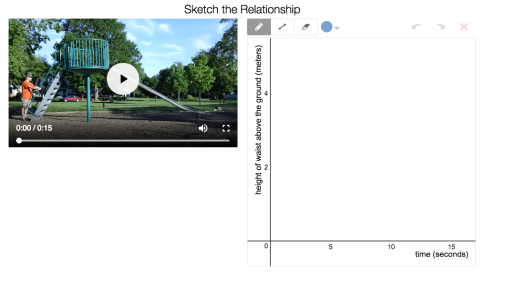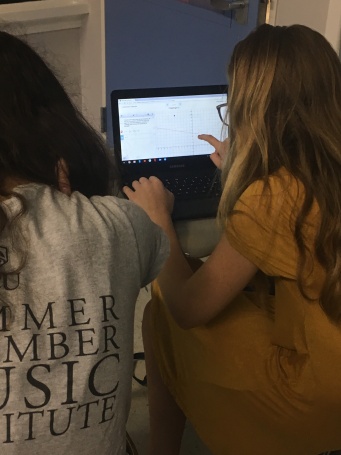 It has been exactly one year since my math department began a discussing the grading practices in our Precalculus course. For many students, this is their first math course requires writing, as well as rigor. I had a student say to me this week that they know the foundational topics in Math 1, 2, and 3, but not to the depth that our Precalculus course uses them. This is part of the learning curve in our course. This brings for many students the first time that they don’t have a 99% average in their math course. I had students tell me last school year that they NEED an A, not an A-. The depth, the writing, and the grade challenge of the course brought stress upon students. Also, to add into the mix of all that, a difference in grading philosophies within our math department. All of this led our department on a year long trek to Standards Based Grading.
It has been exactly one year since my math department began a discussing the grading practices in our Precalculus course. For many students, this is their first math course requires writing, as well as rigor. I had a student say to me this week that they know the foundational topics in Math 1, 2, and 3, but not to the depth that our Precalculus course uses them. This is part of the learning curve in our course. This brings for many students the first time that they don’t have a 99% average in their math course. I had students tell me last school year that they NEED an A, not an A-. The depth, the writing, and the grade challenge of the course brought stress upon students. Also, to add into the mix of all that, a difference in grading philosophies within our math department. All of this led our department on a year long trek to Standards Based Grading.
It has officially been 4 weeks since the first day of school for the 2018-2019 school year. In NC, we are currently experiencing Hurricane Florence and school is closed for the next two days. This morning I have found my brain reflecting on the use of Standards Based Grading in my Precalculus over the past month
I can officially say that I am IN LOVE with Standards Based Grading! With that said, I am NOT an expert in this philosophy of grading by any means.
I use a rubric to grade the students on daily practice (formerly known as homework), and a weekly concept quiz.

This rubric has brought so much freedom in my grading! In past years, every step in a problem had to have a point value. If my precalculus student added the 3 instead of subtracting the three, there was a penalty. If they didn’t reduce the fractional answer, there was a penalty. The grading was so tedious. The students felt like failures because I would mark every little mistake. I still make corrections on their papers now, but they can still get a 2 on using function notation if they don’t reduce their fractional answer.
On the second concept quiz day, I had a student say to me that she realized there was nothing to be stressed over for quiz day. She said getting a 1 as a score was easier to process than getting a B on the quiz. She knew that she would see the question type come around three times on the concept quizzes. If she still didn’t get a 2 after three tries, then she could request a student initiated reassessment. She appreciates the low pressure grading on her.
I thought that the weekly concept quizzes might be burdensome to me due to writing one each week, on the contrary it hasn’t been. These concept quizzes are short. The students have 30 minutes to complete them. I then have the 30 minutes after for my creativity.
These weekly concept quizzes have eliminated test review days. Last year, almost every unit had two days for review. I have gained two hours per unit for instructional use by eliminating review days. The students are reviewing on their own weekly because the concept quizzes build every week. They have to be prepared to answer any question from day one of the class until current day in the class. I also try to do an after quiz activity that reviews previously taught material.
Activity #1
 The first activity that the students did was Graphing Stories in Desmos Activity Builder. There were two goals in mind in using this activity. I used the activity to help the students begin to visual the path of the graphs and what they symbolize. This goal of the activity was used to prepare them for reviewing all the parent functions the following day in class. Goal two was to review from the week before how to determine the intervals that the graph is increasing or decreasing, as well as if the graph had concavity. I also asked them to recall what about the rate of change caused these graph characteristics to occur.
The first activity that the students did was Graphing Stories in Desmos Activity Builder. There were two goals in mind in using this activity. I used the activity to help the students begin to visual the path of the graphs and what they symbolize. This goal of the activity was used to prepare them for reviewing all the parent functions the following day in class. Goal two was to review from the week before how to determine the intervals that the graph is increasing or decreasing, as well as if the graph had concavity. I also asked them to recall what about the rate of change caused these graph characteristics to occur.
Activity #2
For the second activity the students worked to complete a logic puzzle. I have two sections of Precalculus so I gave a different puzzle to each class. I didn’t want the morning class to tell the afternoon class how to solve the puzzle. I found these puzzles from a post that Sarah Carter shared on her blog.

The morning class tried to solve the 8 Letter Squares paper fold. It took me several tries, sharing the activity with two of my coworkers, then finally figuring it out over lunch to get the solution. One of my students solved the paper fold with in FIVE MINUTES! The class couldn’t believe it! By lunch I had students that I didn’t know coming me with the paper fold, telling that one of my students shared it with them, and asking if they solved it correctly. I wasn’t expecting to get a response like this, and it was exciting.
The afternoon class worked on the color square in groups of 2. The atmosphere in the room was exciting. There was a constant hum of talking and discussing of ideas. I had two groups solve the puzzle, but in different ways within the 30 minutes allotted. The students asked if in a few weeks they could do the activity that the morning class completed.
Activity #3
This activity came on the week after we had reviewed all the parent functions, vertical shifts/reflections/compressions/stretches, as well as horizontal shifts and reflections. I learned about Sean Sweeney’s Marbleslides at TMC this summer and found them very addictive myself. My students really got into the activity as well. Sean just released a new set of challenges this week!

I used the new pacing feature that Desmos added back in the summer. I let the students work through the first two challenges on their own. I took snap shots of those and we talked about the different visions within class of how the students saw each challenge before I let them move on.

I plan to do the activity again now that we have reviewed piecewise functions and require them to add in domain restrictions with the functions.
In three weeks, the students will take a Mid-Term. This will be their first big assessment. I am anxious to see if and how the weekly quizzes affects how much time they need to prepare and their score on the assessment.



